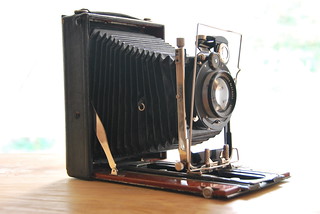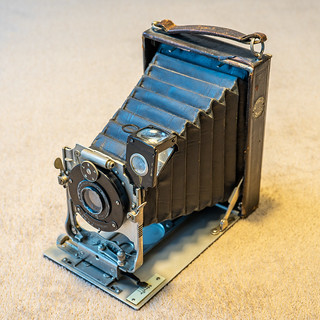Difference between revisions of "Hüttig"
Hanskerensky (talk | contribs) (Added link to Wikipedia page) |
(major rebuild and addition to the history section) |
||
| Line 1: | Line 1: | ||
{{Dresden}} | {{Dresden}} | ||
| + | '''Richard Hüttig & Sohn''' (later '''Hüttig AG''') had been the biggest European camera maker for a certain period. It was the first company in Dresden that produced a [[SLR|single lens reflex camera]], the '''Zeus-Spiegel-Kamera'''. In 1909 Hüttig merged with three other camera producers and became the core of the new [[ICA]] company, which had its headquarter at Schandauer Straße 76 in Dresden, the former Hüttig factory. Eventually, this was also the nucleus of [[Zeiss Ikon]] in 1926. | ||
| + | {{LeftTOC}} | ||
| + | {{brl}} | ||
| + | ==History== | ||
| + | '''Richard Hüttig''' (*10.9.1827 in Leopoldshain, Silesia) grew up as the son of the pastor Karl Hüttig <ref>[https://de.wikipedia.org/wiki/Richard_H%C3%BCttig_(Unternehmer) (German) Wikipedia]</ref>. He learned the profession of a carpenter in neighboring Görlitz and moved to Berlin in 1856, where he found a job in the workshop of master carpenter Hessler, which made precision one-off studio cameras. | ||
| − | In | + | In 1862, Hüttig founded his own workshop in Berlin because the need for cameras was growing rapidly. At first he copied French and English models, but kept improving them with his own ideas. As the competition between camera makers grew, Hüttig left Berlin in 1887 and opened a new workshop in Dresden at Chemnitzer Strasse 12 with four other colleagues. Hüttig chose Dresden because some manufacturers of photographic paper were already based here, but hardly produced any serious competitors. |
| − | |||
| − | |||
| − | + | Craftsmanship and a strong business acumen resulted in rapid growth of the business. In 1889 [[George Eastman]] visited Hüttig to recruit him for his services. Hüttig declined. Richard's son '''Carl Hüttig''' joined the company and the business moved several times within Dresden to the final place (1896, Schandauer Straße 76). On August 1st, 1897 the company was converted into '''Hüttig AG''' (Aktiengesellschaft: stock corporation), Richard Hüttig retired and Carl became CEO. In 1904 it offered 90 camera types in 400 variations. As late as 1906, newspaper advertisements advertised that Hüttig was Germany's largest camera factory with 800 workers<ref name="Jehmlich">Gerhard Jehmlich, ''Die großindustrielle Entwicklung der Kameraindustrie in Dresden'' in Richard Hüttig, ''Der VEB Pentacon Dresden: Geschichte der Dresdner Kamera- und Kinoindustrie nach 1945'' Sandstein-Verlag, Dresden 2009, ISBN 978-3-940319-75-3</ref>. Business mistakes such as an almost unmanageable variety of products, brought Hüttig AG into financial difficulties. In addition, Carl Hüttig was found guilty of financial irregularities in 1904 and sentenced to imprisonment. | |
| − | + | The management was taken over by Guido Mengel (*10.3.1859, +4.1.1946) <ref>Hartmut Thiele, "Die Deutsche Photoindustrie - Wer war Wer", 8th edition, Munich 2021.</ref>, who saved the company into a merger of several Dresden camera factories into a new group. In 1909, Hüttig AG merged into the newly founded [[ICA|Internationale Camera Actiengesellschaft]] together with [[Rudolf Krügener|Kamerawerk Dr. Krügener]] in Frankfurt/Main, [[Emil Wünsche|Wünsche AG]] in Reick near Dresden and [[Carl Zeiss Palmos|Carl Zeiss Palmos AG]] in Jena. The attempt to integrate the Dresdner Ernemann-Werke as a major competitor of Hüttig AG into this new group failed. The Hüttig AG trademark, a pentagram, was adopted by the ICA in a slightly modified form. Eventually, in 1926 ICA was merged into [[Zeiss Ikon| Zeiss Ikon AG]] and Mengel became Zeiss Ikon's first CEO before he retired in 1927. | |
| − | |||
| − | + | After the merger of Hüttig AG with ICA AG in 1909, Richard Hüttig fell into oblivion. He lived alone in a small apartment at Schandauer Straße 40 and only the city of Dresden made sure that he found a place in the Güntz Foundation retirement home so that he could spend his old age in dignity. He died on November 14, 1911 in the Dresden City Hospital, Friedrichstadt. | |
==Cameras== | ==Cameras== | ||
| Line 65: | Line 67: | ||
* Zeus Detectivkamera | * Zeus Detectivkamera | ||
* Zeus-Spiegel-Kamera (1896) I & II | * Zeus-Spiegel-Kamera (1896) I & II | ||
| − | + | ==References== | |
| + | <references /> | ||
==Links== | ==Links== | ||
In German: | In German: | ||
Revision as of 20:21, 1 April 2023
| Camera industry in Dresden |
| Balda | Certo | Eho-Altissa | Eichapfel | Ernemann | Feinmess | Heyde | Hamaphot | Huth | Hüttig | ICA | Ihagee | Kochmann | Kerman | KW | Eugen Loeber | Ludwig | Mentor | Merkel | Meyer | Mimosa | Pentacon | Richter | Sommer | Stübiger | Unger & Hoffmann | Werner | Wünsche | Zeiss Ikon | Zeh |
| Camera distributors in Dresden |
| Stöckig |
| Camera industry in Freital |
| Beier | Pouva | Stein & Binnewerg | Thowe | Welta |
Richard Hüttig & Sohn (later Hüttig AG) had been the biggest European camera maker for a certain period. It was the first company in Dresden that produced a single lens reflex camera, the Zeus-Spiegel-Kamera. In 1909 Hüttig merged with three other camera producers and became the core of the new ICA company, which had its headquarter at Schandauer Straße 76 in Dresden, the former Hüttig factory. Eventually, this was also the nucleus of Zeiss Ikon in 1926.
Contents |
History
Richard Hüttig (*10.9.1827 in Leopoldshain, Silesia) grew up as the son of the pastor Karl Hüttig [1]. He learned the profession of a carpenter in neighboring Görlitz and moved to Berlin in 1856, where he found a job in the workshop of master carpenter Hessler, which made precision one-off studio cameras.
In 1862, Hüttig founded his own workshop in Berlin because the need for cameras was growing rapidly. At first he copied French and English models, but kept improving them with his own ideas. As the competition between camera makers grew, Hüttig left Berlin in 1887 and opened a new workshop in Dresden at Chemnitzer Strasse 12 with four other colleagues. Hüttig chose Dresden because some manufacturers of photographic paper were already based here, but hardly produced any serious competitors.
Craftsmanship and a strong business acumen resulted in rapid growth of the business. In 1889 George Eastman visited Hüttig to recruit him for his services. Hüttig declined. Richard's son Carl Hüttig joined the company and the business moved several times within Dresden to the final place (1896, Schandauer Straße 76). On August 1st, 1897 the company was converted into Hüttig AG (Aktiengesellschaft: stock corporation), Richard Hüttig retired and Carl became CEO. In 1904 it offered 90 camera types in 400 variations. As late as 1906, newspaper advertisements advertised that Hüttig was Germany's largest camera factory with 800 workers[2]. Business mistakes such as an almost unmanageable variety of products, brought Hüttig AG into financial difficulties. In addition, Carl Hüttig was found guilty of financial irregularities in 1904 and sentenced to imprisonment.
The management was taken over by Guido Mengel (*10.3.1859, +4.1.1946) [3], who saved the company into a merger of several Dresden camera factories into a new group. In 1909, Hüttig AG merged into the newly founded Internationale Camera Actiengesellschaft together with Kamerawerk Dr. Krügener in Frankfurt/Main, Wünsche AG in Reick near Dresden and Carl Zeiss Palmos AG in Jena. The attempt to integrate the Dresdner Ernemann-Werke as a major competitor of Hüttig AG into this new group failed. The Hüttig AG trademark, a pentagram, was adopted by the ICA in a slightly modified form. Eventually, in 1926 ICA was merged into Zeiss Ikon AG and Mengel became Zeiss Ikon's first CEO before he retired in 1927.
After the merger of Hüttig AG with ICA AG in 1909, Richard Hüttig fell into oblivion. He lived alone in a small apartment at Schandauer Straße 40 and only the city of Dresden made sure that he found a place in the Güntz Foundation retirement home so that he could spend his old age in dignity. He died on November 14, 1911 in the Dresden City Hospital, Friedrichstadt.
Cameras
- Afpi
- Atom (4.5×6cm folding, 1908)
- Aviso (4.5×6cm magazine camera, 1907)
- Box Kamera (1890)
- Briefmarkenkamera (earlier sold in England by Butcher's)
- Cameo & Cameo Stereo
- Carmen
- Cosmopolit
- Cupido

|
| folding bed camera (1907) image by julochka (Image rights) |
- Cupido Stereolette
- Elegant
- Excelsior
- Fichtners Excelsior Geheimkamera
- Furror Detektiv Kamera
- Gnom (4.5×6, 6.5×9 or 9×12 magazine camera, 1900)
- Halifax
- Hekla
- Helios
- Hochtourist
- Ideal (9×12cm folding, 1908)
- Ideal Stereo

|
| Hüttig Ideal (1908) image by Jaap Schelvis (Image rights) |
- Ingo
- Jelco
- Jul
- Künstler-Kamera
- Lloyd
- Stereo-Panorama Lloyd
- Merkur (box, 1900)
- Monopol
- Monopol Stereo
- Nelson
- Tosca
- Trilby Magazinkamera (1905)
- Zeus Detectivkamera
- Zeus-Spiegel-Kamera (1896) I & II
References
- ↑ (German) Wikipedia
- ↑ Gerhard Jehmlich, Die großindustrielle Entwicklung der Kameraindustrie in Dresden in Richard Hüttig, Der VEB Pentacon Dresden: Geschichte der Dresdner Kamera- und Kinoindustrie nach 1945 Sandstein-Verlag, Dresden 2009, ISBN 978-3-940319-75-3
- ↑ Hartmut Thiele, "Die Deutsche Photoindustrie - Wer war Wer", 8th edition, Munich 2021.
Links
In German:
- Hüttig AG page in the German Wikipedia.
In French:
- Hüttig cameras at Sylvain Halgand's Collection Appareils
- Huttig page at Collection G. Even's site